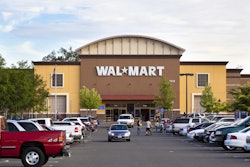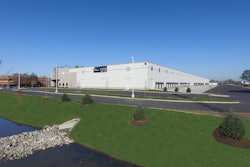
This Black Friday, millions of excited consumers will line up outside stores in the predawn chill, waiting to get their hands on a new iPhone. Millions of others will choose to escape the crowds by making their purchases online. Either way, despite the crowds, there’s no doubt that they’ll be able to get their hands on whatever it is they’re after.
But should there be?
The truth is, it’s easy to forget about the millions of dollars spent getting one phone into one person’s hand. It’s easy to forget about all the ways that phone could get delayed, misplaced or somehow end up in the wrong place. Most of the time, all that stuff works. But sometimes, it doesn’t. There are slipups in the supply chain.
The risks of these disruptions are highest on Black Friday, when consumers are clamoring for a multitude of discounted products. In recent years, an increase in online shopping is adding to logistics problems—and it’s all set to get crazier. For those hoping to get their new iPhone, supply chain disruptions could mean the difference between a jolly and disappointing holiday season.
A Brief Introduction to Supply Chain
Between the people who draw up the initial designs for the iPhone and the moment you take it out of its box lies an incredibly complex supply chain. It encompasses the manufacturing of products and all their parts (and all their parts’ parts, etc.), as well as the storage and movement of all those products to their intended destinations. It’s a $25 trillion industry that affects you in a million ways, every day.
Especially on Black Friday.
Because supply chain problems are exacerbated during high-traffic shopping periods (or big shifts in consumer habits), Black Friday represents the most hectic time of year in the industry.
The Changing Commerce Landscape
In 2014, retail sales for Black Friday dipped 11 percent. However, e-commerce grew by 26 percent, representing $1.5 billion in sales for the U.S. alone. As e-commerce gets easier and more mobile-friendly, retailers are being forced to reconsider their logistics operations to successfully fulfill consumer needs. It’s not a simple task and it involves months of preparation—but the consequences of under-preparing can be severe.
The main issue lies in companies trying to stretch their existing supply chains to serve both e-commerce and in-store sales. Retailers can run out of stock too quickly because they over-stretched their supply—and left holes. In reality, companies have to redesign their supply chains to increase agility, allowing products to easily move depending on demand. It’s an added headache for product companies, but it gives consumers a better chance of actually getting that latest toy after standing in line for three hours.
Lessons from Last Year
After the failures and successes of last year’s Black Friday surfaced, we saw a few key takeaways that retailers should focus on.
Online Shopping Is Proving More Difficult to Accommodate than Expected
Smartphones drove 34.7 percent of all online traffic and online shopping as a whole increased by 26 percent in 2014. Customers spent $1.3 billion from the comfort of their own homes—and that number is expected to grow this year. What most consumers don’t realize is that shopping online changes the supply chain of the product—and if the company isn’t prepared—it could affect their ability to provide that product.
One of the biggest issues that arises is not an actual lack of inventory—companies are generally prepared for the crowds—but poor planning when it comes to stocking. There’s nothing more frustrating for customers than shopping for items advertised as in stock, but having them end up being back-ordered. That’s because, when companies are ill-prepared for the popularity of e-commerce, they don’t do enough to make sure their customers are getting the most up-to-date information online. They can also suffer from storing too much inventory in the wrong warehouses, which leads to stock shortages in store. Take Force Friday, for example: September 4th was supposed to be a night of carefree spending for Star Wars fans—but many were disappointed to find stores laughably understocked. The same thing is happening in large retail stores across the U.S. as companies struggle to understand how to balance the rise of online shopping with traditional brick-and-mortar sales.
Consumers may be better off shopping online, where transparency is built in and it’s easier to track your package after the purchase. The most trouble comes from trying to pick up in store from an online order, because companies are slow at updating stock information—or they simply can’t keep up with transactions.
Retailers, on the other hand, should work to boost transparency of their supply chains by utilizing data and real-time updates. Much of the time, supply chain disruptions can been prevented if companies could understand their data and act fast enough. It’s about taking advantage of new technologies to act on change, rather than sticking to old ways of moving inventory. It perhaps worked in the past, but e-commerce is shaking up logistics for good.
There Are Always Going to Be Surprises and Agile Supply Chains Win Out
Department stores must take time to prepare for Black Friday, but their inventory has to be ready to deal with changes at a moment’s notice. For all the data available, surprises still hit retailers—just like last year’s surprising dip of 6 million in expected in-store shoppers, many of whom chose to browse from their couches instead. Retailers need to be prepared to move inventory quickly, and it starts with changes in storage and movement—not just of things, but also of information about those things.
Ordinarily, retailers store their inventory in centralized warehouses—distributing items shortly before they are needed. But with the rise of e-commerce, the size of warehouses is starting to vary greatly. For speedy deliveries—quickly becoming the norm—smaller, more urban warehouses are necessary. But increasingly, supersized warehouses like Amazon’s huge distribution centers are becoming the norm. These warehouses often employ robots and humans to run the giant mass of inventory efficiently.
But the bigger change needs to lie in the movement of information. The supply chain industry is a notoriously slow adopter of technology, but when it’s easier to find out what your cousin had for breakfast than where millions of dollars of inventory are, you know you have a problem. And it’s not just about big shopping holidays. This year, we saw explosions, typhoons, strikes and poor planning disrupt supply chains, and it’s only through a faster, freer flow of information that supply chain teams can keep your iPhone on the shelf.


















